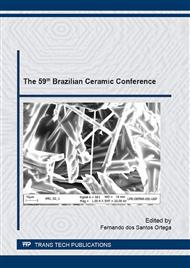p.83
p.91
p.97
p.103
p.111
p.117
p.123
p.128
p.134
The Influence of Microstructure, Temperature and Sintering Level on Electric Properties of Electrical Insulators Obtained from Raw Materials of Rio Grande do Norte - Brazil
Abstract:
The technical porcelain is usually obtained by mixing different raw materials, which are generally clay, kaolin, quartz, and a fluxing agent, in appropriate amounts. These porcelains are used in the production of electric and electronic devices for several applications, ranging from high and low power capacitors to low, medium, high and extra high voltage insulators. In this work, we studied technological properties of dielectric porcelain, obtained from raw materials found in large quantities and excellent quality in the Rio Grande do Norte state in Brazil. Test samples were produced by powder technology for two different compositions: composition A (20% clay, 28% kaolin, 32% feldspar and 20% quartz) and composition B (15% clay, 31% kaolin, 33% feldspar and 21% quartz), and sintered at temperatures, T1=1150°C, T2=1200°C, T3=1250°C, T4=1300°C and T5=1350°C with isotherms P1=0.5 hours, P2=1 hour, P3=1.5 hours and P4=2 hours. Then after sintered, the sample microstructure was characterized by scanning electron microscopy (SEM) and analysis of dielectric strength with direct and alternating voltage. The best results for electrical properties were obtained in temperature of 1250oC for composition A, and confirms the electrotechnical porcelain production feasibility.
Info:
Periodical:
Pages:
111-116
Citation:
Online since:
November 2016
Keywords:
Price:
Сopyright:
© 2017 Trans Tech Publications Ltd. All Rights Reserved
Share:
Citation:


